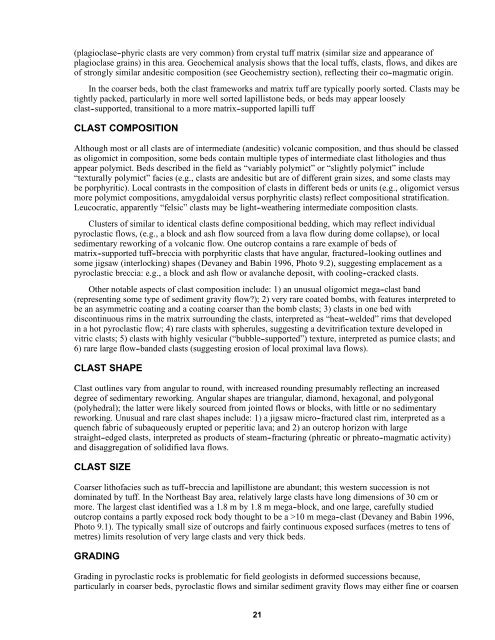Regional Geology, Sioux Lookout Orogenic Belt - Geology Ontario
Regional Geology, Sioux Lookout Orogenic Belt - Geology Ontario
Regional Geology, Sioux Lookout Orogenic Belt - Geology Ontario
Create successful ePaper yourself
Turn your PDF publications into a flip-book with our unique Google optimized e-Paper software.
(plagioclase--phyric clasts are very common) from crystal tuff matrix (similar size and appearance of<br />
plagioclase grains) in this area. Geochemical analysis shows that the local tuffs, clasts, flows, and dikes are<br />
of strongly similar andesitic composition (see Geochemistry section), reflecting their co--magmatic origin.<br />
In the coarser beds, both the clast frameworks and matrix tuff are typically poorly sorted. Clasts may be<br />
tightly packed, particularly in more well sorted lapillistone beds, or beds may appear loosely<br />
clast--supported, transitional to a more matrix--supported lapilli tuff<br />
CLAST COMPOSITION<br />
Although most or all clasts are of intermediate (andesitic) volcanic composition, and thus should be classed<br />
as oligomict in composition, some beds contain multiple types of intermediate clast lithologies and thus<br />
appear polymict. Beds described in the field as “variably polymict” or “slightly polymict” include<br />
“texturally polymict” facies (e.g., clasts are andesitic but are of different grain sizes, and some clasts may<br />
be porphyritic). Local contrasts in the composition of clasts in different beds or units (e.g., oligomict versus<br />
more polymict compositions, amygdaloidal versus porphyritic clasts) reflect compositional stratification.<br />
Leucocratic, apparently “felsic” clasts may be light--weathering intermediate composition clasts.<br />
Clusters of similar to identical clasts define compositional bedding, which may reflect individual<br />
pyroclastic flows, (e.g., a block and ash flow sourced from a lava flow during dome collapse), or local<br />
sedimentary reworking of a volcanic flow. One outcrop contains a rare example of beds of<br />
matrix--supported tuff--breccia with porphyritic clasts that have angular, fractured--looking outlines and<br />
some jigsaw (interlocking) shapes (Devaney and Babin 1996, Photo 9.2), suggesting emplacement as a<br />
pyroclastic breccia: e.g., a block and ash flow or avalanche deposit, with cooling--cracked clasts.<br />
Other notable aspects of clast composition include: 1) an unusual oligomict mega--clast band<br />
(representing some type of sediment gravity flow?); 2) very rare coated bombs, with features interpreted to<br />
be an asymmetric coating and a coating coarser than the bomb clasts; 3) clasts in one bed with<br />
discontinuous rims in the matrix surrounding the clasts, interpreted as “heat--welded” rims that developed<br />
in a hot pyroclastic flow; 4) rare clasts with spherules, suggesting a devitrification texture developed in<br />
vitric clasts; 5) clasts with highly vesicular (“bubble--supported”) texture, interpreted as pumice clasts; and<br />
6) rare large flow--banded clasts (suggesting erosion of local proximal lava flows).<br />
CLAST SHAPE<br />
Clast outlines vary from angular to round, with increased rounding presumably reflecting an increased<br />
degree of sedimentary reworking. Angular shapes are triangular, diamond, hexagonal, and polygonal<br />
(polyhedral); the latter were likely sourced from jointed flows or blocks, with little or no sedimentary<br />
reworking. Unusual and rare clast shapes include: 1) a jigsaw micro--fractured clast rim, interpreted as a<br />
quench fabric of subaqueously erupted or peperitic lava; and 2) an outcrop horizon with large<br />
straight--edged clasts, interpreted as products of steam--fracturing (phreatic or phreato--magmatic activity)<br />
and disaggregation of solidified lava flows.<br />
CLAST SIZE<br />
Coarser lithofacies such as tuff--breccia and lapillistone are abundant; this western succession is not<br />
dominated by tuff. In the Northeast Bay area, relatively large clasts have long dimensions of 30 cm or<br />
more. The largest clast identified was a 1.8 m by 1.8 m mega--block, and one large, carefully studied<br />
outcrop contains a partly exposed rock body thought to be a >10 m mega--clast (Devaney and Babin 1996,<br />
Photo 9.1). The typically small size of outcrops and fairly continuous exposed surfaces (metres to tens of<br />
metres) limits resolution of very large clasts and very thick beds.<br />
GRADING<br />
Grading in pyroclastic rocks is problematic for field geologists in deformed successions because,<br />
particularly in coarser beds, pyroclastic flows and similar sediment gravity flows may either fine or coarsen<br />
21

















